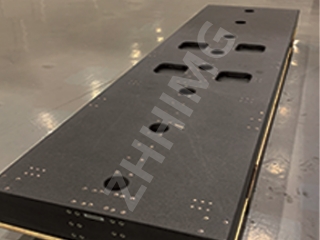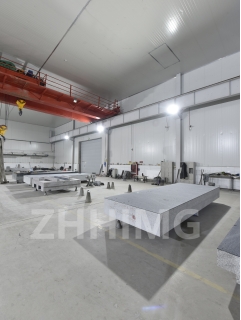In the field of industrial precision equipment, the stability of granite mainly depends on its mineral composition, structural density, and physical performance indicators (such as coefficient of thermal expansion, water absorption rate, and compressive strength), rather than its color itself. However, color often indirectly reflects the differences in mineral composition and formation environment. Therefore, in practical applications, granite of certain colors is more favored due to its superior comprehensive performance. The following is the specific analysis:
I. Indirect Association between Color and Stability
The color of granite is determined by its mineral composition, and the mineral composition directly affects its physical properties:
Light-colored granite (such as grayish white, light pink)
Mineral composition: Mainly quartz and feldspar (accounting for up to 60% to 80%), with a small amount of mica or amphibole.
Quartz (with a density of 2.65g/cm³) and feldspar (with a density of 2.5-2.8g/cm³) have high hardness, strong chemical stability, and a low coefficient of thermal expansion (typically 5-8×10⁻⁶/℃), and are not easily affected by temperature changes.

Structural features: Formed in a relatively stable geological environment (such as slow cooling in the shallow part of the Earth's crust), with uniform crystalline particles, dense structure, low porosity (0.3% - 0.7%), low water absorption rate (<0.15%), and strong resistance to deformation.
Typical applications: Electronic chip manufacturing equipment, precision optical instrument bases (such as photolithography machine platforms), which need to maintain dimensional accuracy for a long time.
Dark granite (such as black, dark green)
Mineral composition: Rich in iron and magnesium minerals (such as amphibole, biotite, pyroxene), and partially contains heavy metal minerals such as magnetite and ilmenite.
Amphibole (density 3.0-3.4g/cm³) and biotite (density 2.7-3.1g/cm³) have relatively high densities, but their coefficients of thermal expansion are slightly higher than those of quartz (up to 8-12×10⁻⁶/℃), and their structures may undergo slight changes due to the oxidation of iron-containing minerals.
Structural characteristics: Mostly formed in high-temperature and high-pressure environments (such as rapid cooling of deep magma), with coarse crystalline particles and significant differences in structural density. Some dark granite (such as Jinan Green) has a more uniform and stable structure due to the intense magmatic activity and the full release of internal stress.
Typical applications: Heavy-duty machine tool bases, large coordinate measuring machines (CMM), which need to withstand high loads and impact resistance.
Ii. Core Indicators of Stability in Industrial Scenarios
Regardless of the color, the core requirements for granite in industrial precision equipment include:
Thermal stability
Give priority to choosing varieties with a low coefficient of thermal expansion (<8×10⁻⁶/℃) to avoid equipment accuracy deviation caused by temperature fluctuations. Light-colored granite (such as sesame white) has better thermal stability due to its high quartz content.
Structural compactness
Granite with a porosity of less than 0.5% and a water absorption rate of less than 0.1% is not prone to adsorbing moisture or impurities and is not likely to deform over long-term use. Both Jinan Green in dark granite (with a porosity of 0.3%) and Shanxi Black in light granite (with a porosity of 0.2%) meet the requirements of high density.
Mechanical strength
The compressive strength is greater than 150MPa and the flexural strength is greater than 12MPa, ensuring the long-term stability of carrying precision equipment. Dark granite (such as Indian black) usually has higher mechanical strength due to the presence of iron and magnesium minerals and is suitable for heavy-duty scenarios.
Chemical corrosion resistance
Quartz and feldspar have strong resistance to acid and alkali corrosion. Therefore, light-colored granite (such as sesame grey) is more suitable for corrosive environments in the chemical and semiconductor industries.
Iii. Mainstream Choices and Cases in the Industrial Field
Light-colored granite: The preferred choice for high-precision scenarios
Representative varieties:
Sesame White: Produced in Fujian, it is light gray in color, with a quartz content of over 70%. Its coefficient of thermal expansion is 6×10⁻⁶/℃. It is used in semiconductor lithography machine platforms and aerospace inspection equipment.
Jinan Green: Dark gray, uniform structure, compressive strength 240MPa, often used for the base of coordinate measuring machines (CMM).
Advantages: Good color uniformity, facilitating the optical path calibration of optical equipment; It has small thermal deformation and is suitable for nanometer-level precision requirements.
Dark granite: Preferred for heavy-duty and impact-resistant scenarios
Representative varieties:
Black Galaxy: Black in color, containing ilmenite, with a density of 3.05g/cm³ and a compressive strength of 280MPa. It is used for heavy-duty machine tool guide rails and automotive manufacturing fixtures.
Mongolian black: Dark green, mainly amphibole, with strong impact resistance, used for the base of mining equipment.
Advantages: High density, strong rigidity, capable of absorbing mechanical vibration, suitable for high-load industrial environments.
Four. Conclusion: Color is not the determining factor; performance is the core
Color ≠ stability: Both light-colored and dark-colored granite have highly stable varieties. The key lies in the purity of the mineral, the uniformity of the structure, and physical indicators.
Scene adaptation principle:
Precision optical/electronic equipment: Select light-colored varieties with high quartz content (such as sesame white), emphasizing thermal stability and surface accuracy.
Heavy machinery/industrial machine tools: Select dark-colored, high-iron magnesium ore types (such as Jinan blue), emphasizing mechanical strength and impact resistance.
Purchase suggestion: Verify parameters such as the coefficient of thermal expansion, water absorption rate, and compressive strength through test reports (such as GB/T 18601-2020 "Natural Granite Building Slabs"), rather than judging only by color.
In conclusion, in the industrial field, the selection of granite prioritizes performance and is supplemented by color. A comprehensive assessment should be made in combination with specific equipment requirements and usage environments.
Post time: May-19-2025

